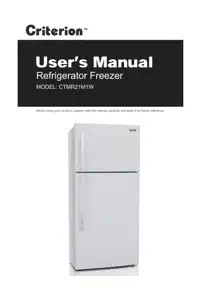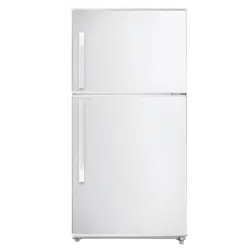Documents: Go to download!
- Owner's manual - (English)

- Proper use of refrigerators
- Structure and functions
- Maintenance and care of the refrigerator
- Trouble shooting
Table of contents
User Manual
Proper use of refrigerators
Placement
 |
Before use, remove all packing materials, including bottom cushions, foam pads and tapes inside of the refrigerator; tear off the protective film on the doors and the refrigerator body. |
|
 |
Keep away from heat and avoid direct sunlight. Do not place the freezer in moist or watery places to prevent rust or reduction of insulating effect. Do not spray or wash the refrigerator; do not put the refrigerator in moist places easy to be splashed with water so as not to affect the electrical insulation properties of the refrigerator. |
|
 |
The refrigerator is placed in a well-ventilated indoor place; the ground shall be flat, and sturdy (rotate left or right to adjust the wheel for leveling if unstable). |
|
 |
The top space of the refrigerator shall be greater than 30cm, and
The refrigerator should be placed against a wall with a free distance more than 10cm to facilitate heat dissipation.
|
Door handle installation
Precautions shall be taken to prevent fall of the handle from causing any personal injury.

Explanatory notes:
- Bolt
- Bolt hole
- Handle screw
- Screw hole cap
Installation procedures:
Levelling feet
Schematic diagram of the leveling feet

(The picture above is only for reference. The actual configuration will depend on the physical product or statement by the distributor)
Adjusting procedures:
Door Right-Left Change


2. Remove the hinge cover plate and the right top hinge cover, then unscrew screws and remove the right top hinge.



7. Remove the hole cap from the top left of the refrigerator door and install it on the other side.

8. Remove the door stopper from the bottom right side of the freezer and refrigerator door and install them on the other side.


11. Take out the top hinge and top hinge cover from the accessory bag in the refrigerator. Put down the freezer door on middle hinge vertically, then install the top hinge and hinge cover, finally to install the cover plate you previously removed. For the assembly of handle, please refer to chapter 2.2.

Changing the Light
Any replacement or maintenance of the LED lamps is intended to be made by the manufacturer, its service agent or similar qualified person.
Starting
 |
Before initial start, keep the refrigerator still for half an hour before connecting it to power supply. Before putting any fresh or frozen foods, the refrigerator shall have run for 2-3 hours, or for above 4 hours in summer when the ambient temperature is high. |
|
 |
Spare enough space for convenient opening of the doors and drawers or statement by the distributor. |
Energy saving tips
- The appliance should be located in the coolest area of the room, away from heat producing appliances or heating ducts, and out of the direct sunlight.
- Let hot foods cool to room temperature before placing in the appliance. Overloading the appliance forces the compressor to run longer. Foods that freeze too slowly may lose quality, or spoil.
- Be sure to wrap foods properly, and wipe containers dry before placing them in the appliance. This cuts down on frost build-up inside the appliance.
- Appliance storage bin should not be lined with aluminum foil, wax paper, or paper toweling. Liners interfere with cold air circulation, making the appliance less efficient.
- Organize and label food to reduce door openings and extended searches. Remove as many items as needed at one time, and close the door as soon as possible.
Structure and functions
Key components

Refrigerating chamber
- The Refrigerating Chamber is suitable for storage of a variety of fruits, vegetables, beverages and other food consumed in the short term.
- Cooking foods shall not be put in the refrigerating chamber until cooled to room temperature.
- Foods are recommended to be sealed up before putting into the refrigerator.
- The glass shelves can be adjusted up or down for a reasonable amount of storage space and easy use.
Freezing chamber
- The low temperature freezing chamber may keep food fresh for a long time and it is mainly used to store frozen foods and making ice.
- The freezing chamber is suitable for storage of meat, fish, rice balls and other foods not to be consumed in short term.
- Chunks of meat are preferably to be divided into small pieces for easy access. Please be noted food shall be consumed within the shelf time.
Functions

2. Display screen
- temperature setting1
- temperature setting2
- temperature setting3
- temperature setting4
- temperature setting5
- Standby indicator
3. Display
4. Temperature setting

5. Standby mode
When the refrigerator is running, long press the temperature setting button last for 3 seconds, the refrigerator enters into standby mode, and the standby indicator shines, the refrigerator stops running; when the refrigerator is in standby mode, short press the temperature setting button, the refrigerator re-starts normal running, and standby indicator goes out.
6. Fault indication
The following warnings appearing on the display indicate corresponding faults of the refrigerator. Though the refrigerator may still have refrigerator and freezing function with the following faults, the user shall contact a maintenance specialist for maintenance, so as to ensure normal use of the refrigerator.

Maintenance and care of the refrigerator
Overall cleaning
- Dusts behind the refrigerator and on the ground shall be timely cleaned to improve the cooling effect and energy saving. The interior of the refrigerator should be cleaned regularly to avoid odor. Soft towels or sponge dipped in water and non-corrosive neutral detergents are suggested for cleaning. The freezer of shall be finally cleaned with clean water and dry cloth. Open the door for natural drying before the power is turned on.
- Do not use hard brushes, clean steel balls, wire brushes, abrasives, such as toothpastes, organic solvents (such as alcohol, acetone, banana oil, etc.), boiling water, acid or alkaline items clean refrigerator considering that this may damage the fridge surface and interior.
- Do not rinse with water so as not to affect the electrical insulation properties.

Warnings: Please unplug the refrigerator for defrost and cleaning.
Defrosting
The refrigerator is made based on the air-cooling principle and thus has automatic defrosting function. Frost formed due to change of season or temperature may also be manually removed by disconnection of the appliance from power supply or by wiping with a dry towel.
Out of operation
- Power failure: In case of power failure, even if it is in summer, foods inside the appliance can be kept for several hours; during the power failure, the times of door opening shall be reduced, and no more fresh food shall be put into the appliance.
- Long-time nonuse: The appliance shall be unplugged and then cleaned; then the doors are left open to prevent odor.
- Moving: Before the refrigerator is moved, take all objects inside out, fix the glass partitions, vegetable holder, freezing chamber drawers and etc. with tape, and tighten the levelling feet; close the doors and fix them with tape. During moving, the appliance shall not be laid upside down or horizontally, or be vibrated; the inclination during movement shall be no more than 45°.
Warnings: The appliance shall run continuously once it is started. Generally, the operation of the appliance shall not be interrupted;otherwise the service life may be impaired.
Trouble shooting
Failed operation
- Check whether the appliance is connected to power or whether the plug is in well contact
- Check whether the voltage is too low
- Check whether there is a power failure or partial circuits have tripped
Odor
- Odorous foods shall be tightly wrapped
- Check whether there is any rotten food
- Clean the inside of the refrigerator
Long-time operation of the compressor
- Long operation of the refrigerator is normal in summer when the ambient temperature is high
- It is not recommended having too much food in the appliance at the same time
- Food shall get cool before being put into the appliance
- The doors are opened too frequently
Light fails to get lit
- Check whether the refrigerator is connected to power supply and whether the illuminating light is damaged
Doors cannot be properly closed
- The door is stuck by food packages
- The refrigerator is tilted
Loud noise
- Check whether the floor is level and whether the refrigerator is placed stably
- Check whether accessories are placed at proper locations
Door seal fails to be tight
- Remove foreign matters on the door seal
- Heat the door seal and then cool it for restoration (or blow it with an electrical drier or use a hot towel for heating)
Water pan overflows
- There is too much food in the chamber or food stored contains too much water,resulting in heavy defrosting
- The doors are not closed properly, resulting in frosting due to entry of air and increased water due to defrosting
Hot housing
- Heat dissipation of the built-in condenser via the housing, which is normal.
- When housing becomes hot due to high ambient temperature and storage of too much food,it is recommended to provide sound ventilation to facilitate heat dissipation.
Surface condensation
- Condensation on the exterior surface and door seals of the refrigerator is normal when the ambient humidity is too high. Just wipe the condensate with a clean towel.
Abnormal noise
- Buzz: The compressor may produce buzzes during operation, and the buzzes are loud particularly upon start or stop. This is normal.
- Creak: Refrigerant flowing inside of the appliance may produce creak, which is normal.
See other models: CTMR145A1W CCR312DCE2S CFRR211P1S
